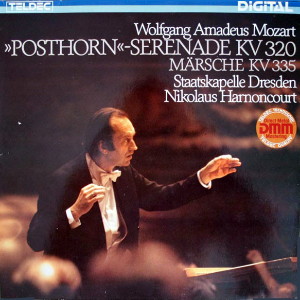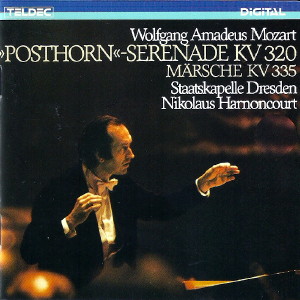 |
1 LP -
6.43063 AZ - (p) 1984
|
 |
| 1 CD -
8.43063 ZK - (p) 1984 |
|
| Wolfgang
Amadeus Mozart (1756-1791) |
|
|
|
|
|
|
|
| Marsch D-dur, KV 335 (320a)
Nr. 1 |
|
4' 03" |
A1 |
Serenade D-dur, KV 320
"Posthorn-Serenade"
|
|
47' 51" |
|
- Adagio maestoso - Allegro
con spirito
|
8' 51" |
|
A2 |
| - Menuetto:
Allegretto - Trio |
4' 08" |
|
A3 |
| - Concertante: Andante
grazioso |
9' 09" |
|
A4 |
| - Rondeau: Allegro ma non
troppo |
6' 27" |
|
A5 |
- Andantino
|
10' 26" |
|
B1 |
- Menuetto - Trio I - Trio
II *
|
4' 45" |
|
B2 |
- Finale: Presto
|
4' 05" |
|
B3 |
| Marsch D-dur, KV 335 (320a)
Nr. 2 |
|
|
|
- Maestoso assai
|
|
4' 04" |
B4 |
|
|
|
|
| Peter Damm, Posthorn * |
|
| Staatskapelle
Dresden |
|
|
|
| Nikolaus
Harnoncourt, Dirigent |
|
|
Luogo
e data di registrazione
|
Studio
Lukaskirche, Dresda (Germania) - 1984
|
|
Registrazione
live / studio
|
| studio |
Producer
/ Engineer
|
Heinrich
J. Weritz / Helmut A. Mühle / Martin
Fouquè / Michael Brammann
|
Prima Edizione CD
|
| Teldec
- 8.43063 ZK - (1 cd) - 56' 23" - (p)
1984 - DDD |
Prima
Edizione LP
|
Teldec - 6.43063
AZ - (1 lp) - 56'
23"
- (p) 1984 -
Digital
|
Nota
|
| Co-Produktion
mit VEB Deutsche Schallplatten,
Berlin/DDR |
|
|
Notes
|
The fact that it is not
always easy to classify precisely
a piece of music within the
parameters, part real, part
imagined, of biographical and
aesthetic stratification, does not
necessarily impede interpretation.
Indeed, complete factual
information concerning the genesis
and performance practice, and also
the inexhaustible subject of its
reception by the public,
encourages, if anything, the
consolidation of clichés. In some
circumstances absolute certainty
on the part of musicologists and
executants deteriorates into
tedious complacency, under the
ideological protection of which
the salient elements are
progressively reduced until in the
end even the store of facts
becomes limited to a minimum
supply of convenient pieces of
information.
Mozart completed the great
Serenade in D, K.
320, the last in a series of
so-called Salzburg serenades, in
August 1779.
In this case verifiable tradition,
hypotheses which, from a
musico-historical point of view,
seem plausible, and faulty but
cherished and, as it were,
established opinions appear to
balance one another, so that
careful investigations are bound
to produce new insights. The
leading Mozart scholars made life
easy for themselves by unanimously
stressing the exceptionally
elaborate layout of this
large-scale work. More
conjectural, however, was the
precise characterisation of its
historical setting. The occasion
for which Mozart wrote the seven
movements and the significance of
the personal “information” which
he worked into the composition and
with which he enriched it, have
remained in the thrilling twilight
of anecdotal speculation.
The statement by Mozart’s
biographer Franz Xaver Niemetschek
(1766-1849) that the serenade was
written expressely for name day of
Prince Archbishop Colloredo of
Salzburg has been rejected for the
good reason that this was not
celebrated until 30th September.
The manner in which Albert
Einstein expressed his view of the
situation indicates the degree to
which the affective “language” of
this composition suggests a coded
“description” of wellknown
personalities of the day or
politico-cultural events. But Einstein,
too, thought he could detect a
reference to Colloredo, “for in
the first movement the
relationship between Mozart and
the Prince Archbishop is depicted
in a manner which is, to be sure,
merely musical and symbolic, but
nevertheless obvious and humorous,
The introductory six-bar Adagio
maestoso, which returns ‘in tempo’
in the recapitulation, announces,
with a high degree of tension, an
extremely aggressive Allegro con
spirito, the beginning of which
could hardly be classified
otherwise than as a forerunner of
the opening of the first movement
of the Prague Symphony - except
that this opening is fundamentally
‘galant’ and not yet ‘contrapuntal'.
With the second theme the conflict
develops into total opposition:
the Archbishop counters all
Mozart’s pleas with an inflexible
'No'. It is quite in
keeping with Mozart’s character to
permit the unwitting Archbishop to
hear this, and with such a
portrait to exact an idealised
revenge...”.
One is inclined to accept the
essence of Einstein’s
interpretation, since there are indeed
many passages to be found in this
serenade which appear to express,
in musical terms, address and
reply, the male and female
principle, veiled criticism, the
nostalgia inherent in the
situation and explicit farewell,
all in the noble style typical of
Mozart. Although one may agree
with the casual classification of
the Posthorn Serenade as “a worthy
representative of the species”
(Angermüller)
and force it into the incontestably
all-embracing straitjacket of the
so-called Finalmusiken (serenades
played by the students of Salzburg
University at the end of the
academic year), this is unlikely
to satisfy completely a discerning
interpreter who has just been
overwhelmed by the many levels of
the music.
In the
contrasting alternation of
dancelike, concertante and elegiac movements (or
parts of movements) the manner of
Mozart’s
scoring is particularly
noteworthy. There is no mention of
cellos, but it is possible that in
performance portable instruments
were used, capable of being played
standing up; these are known to
have existed.
One reason for the great
popularity of the work is the use
of a posthorn in the second trio of the penultimate
movement (“Menuetto”).
The posthorn enjoyed a position in
the music and pictorial art of the
romantic period, as a synonym for
farewell, which has been
maintained at the level of viable
symbolism to this day, for all
that it has had to surrender its
acoustic and emotive functions to
other instruments. In the music of
the 18th century Salzburg
attention was time and again
focussed on the posthorn. The fact
that Mozart incorporated it into
this serenade in a manner that, at
first blush, seems cheerfully
noisy, though its subliminal
effect is strangely touching,
makes on stop to think and leads
one back to the premise that this
work contains music of a
profoundly biographical character
in the context of a farewell event
which cannot now be reconstructed.
The prirnitiveness of the posthorn’s natural
notes enhances the
thought-provoking effect on the
listener. One is almost inclined
to conclude that its simplicity
and the ambivalent mood are
dependent on one another.
On this record the Posthorn
Serenade is framed by two Marches,
K. 335 Nos. 1 and 2, which Mozart
also composed in early August
1779. The linking of serenades and marches is
amply supported, even though it
has now become the fashion at
concert performances of the
Posthorn Serenade not to enlarge
still further the substantial
dimensions of the work by a
quasi-prelude and an “appendix”.
However, when the Salzburg
musicians processed through the
town these marches fulfilled the
clearly defined function of
providing musical sustenance for
their journey.
Peter Cossé
Translation: Lindsay
Craig
|
|
Nikolaus
Harnoncourt (1929-2016)
|

|

|
|